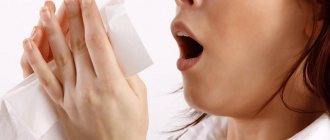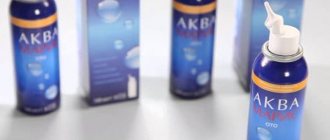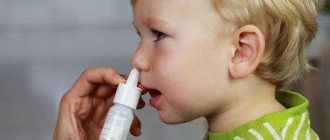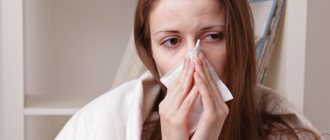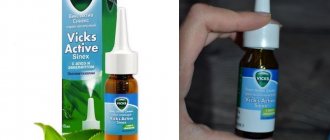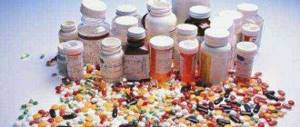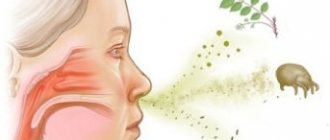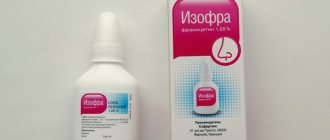Types of cold remedies
Sprays for nasal congestion differ depending on the “points of application,” that is, the pathologies for which they are recommended. Difficulty in nasal breathing is a symptom, not an independent disease. Situations when medications may be recommended:
- Allergy. The nasal mucosa swells due to a hypersensitivity reaction to a specific irritant. For example, during the flowering of some plants.
- Bacterial infections. Breathing problems may occur due to the formation of purulent crusts in the nasal cavity.
- Candidiasis. Fungal rhinitis is relatively rare, but difficult to treat.
- Viral diseases. Breathing becomes difficult due to swelling of the nasal mucosa caused by infectious inflammation.
- Rehabilitation after surgery. The nose is an organ that is well supplied with blood, so tissue swelling quickly develops in response to any damage.
When selecting medications, they rely primarily on the cause of the runny nose.
Plant based
Cold remedies may contain natural ingredients, such as essential oils. These drugs have an antiseptic effect. Plant-based solutions are recommended for use in cases of nasal congestion due to a viral infection. Some representatives:
- Bishupen. The product contains propolis, magnolia liliaceae extract. It has an anti-inflammatory effect and helps thin mucus.
- Sinuforte. Based on extract of European cyclamen tubers. Has a local irritant effect. Stimulates the production of mucus in the nasal cavity and paranasal sinuses, providing natural drainage (cleansing). The manufacturer recommends using it not as an independent remedy, but as part of complex therapy, for example, with an antibiotic (for purulent infection). Sinuforte is good for removing mucus, but does not have an antiseptic or anti-inflammatory effect.
- Sumifun. Chinese remedy. Helps get rid of runny nose thanks to the anti-inflammatory effect of Japanese honeysuckle. Contains natural antiseptics: propolis, ledeburiella spread. Wild peony extract and magnolia lily have a calming, healing effect, reduce discomfort in atrophic rhinitis (inflammation of the nasal mucosa, accompanied by its thinning and fragility). Menthol helps get rid of nasal congestion: it causes a short-term spasm of the vessels of the mucous membrane, reducing its swelling.
Plant-based sprays are generally safe and provide good relief from a runny nose. But, given their rich composition, people prone to allergies should treat them with caution.
With sea salt and water
There are relatively few of these drugs in spray form. More often there are special systems for rinsing the nose in large bottles (from 150 ml).
Based on NaCI (table salt) content, solutions are divided into hypertonic and isotonic. The former are used to eliminate edema: salt “pulls” fluid from the intercellular space of the nasal mucosa. Representatives:
- Physiometer;
- Aqualor Forte;
- Sanorin Aqua.
Sprays based on sea water are effective, but improvement in well-being after rinsing does not occur immediately, but throughout the day. A hypertonic solution may dry out the mucous membrane a little if you use it constantly.
For daily hygienic treatment of the nasal passages, an isotonic solution is more suitable. It is indicated for patients suffering from dry nose, as well as people who frequently come into contact with dust and other air pollutants. Moisturizers belonging to this group:
- Rhinorine;
- Delmar;
- Spray Aqua Maris;
- LinAqua Soft;
- Humer.
It is possible to avoid addiction when using both hypertonic and isotonic solutions. They are allowed to be used not only by adults, but also by children. Solutions based on sea water are safe during pregnancy, regardless of the period.
Despite the advantages considered, rinsing systems should be used with caution: if handled incorrectly, the solution can enter the middle ear and cause otitis media. There are different irrigation devices, so instructions on how to properly inject the medicine may vary depending on the manufacturer.
Hormonal
Sprays containing glucocorticosteroids (GCS). They have a pronounced anti-inflammatory effect and effectively eliminate swelling.
Hormonal drugs are used only in the presence of severe complaints, when other methods of therapy do not help. For example, GCS is prescribed for moderate to severe allergic rhinitis, for prolonged inflammation of the paranasal sinuses, and for the formation of polyps (pathological growth of the mucous membrane). Representatives:
- Nasonex;
- Avamis;
- Aldecin.
Hormonal drugs are non-addictive drugs. The anti-inflammatory response after treatment of the nasal passages is persistent, but does not occur immediately, but within 8 hours.
Sprays for the common cold with GCS are available only by prescription, because the potential harm from improper use is higher than the possible benefit.
Combined
They are a combination of substances from different pharmacological groups. Depending on the composition, they can act simultaneously in several directions: reduce swelling, fight infection, eliminate allergy symptoms. Examples:
- Vibrocil. A combination of phenylephrine and dimethindene (an antihistamine). Vasoconstrictor drug with antiallergic effect. Vibrocil is used in preparation for surgical interventions in the nasal area.
- Sanorin-Analergin. Antihistamine in combination with a vasoconstrictor. Like Vibrocil, it is indicated for allergic rhinitis.
- Sinupret. Combined product of plant origin. The drug contains: gentian root, elderberry and sorrel extract, verbena herb. The spray reduces the viscosity of nasal mucus and promotes its discharge. According to the instructions, it has a mild antibacterial and antiviral effect.
Combined products containing corticosteroids and antibiotics are available with a prescription. Herbal preparations are usually freely available.
Vasoconstrictors
Remedies for the common cold, which are popular because of the fastest, most pronounced effect. Anticongestant substances cause a sharp constriction of the vessels of the nasal mucosa. This results in a temporary reduction in blood flow to the area of application. The effect occurs within 10 minutes and lasts at least 4-6 hours.
Vasoconstrictors (anticongestants):
- Naphthyzin drops (naphazoline). One of the very first vasoconstrictor drugs.
- Tizine (tetrizoline). It has the fastest possible effect. The swelling disappears within 1 minute after application, the effect lasts up to 8 hours. There are release forms for children.
- Nazole (oxymetazoline). The effect of the medicine is long-lasting: symptoms of a runny nose disappear for 12 hours, 10-15 minutes after application.
Despite the pronounced effect, drugs in this group are not without drawbacks. They are suitable only for symptomatic treatment of the runny nose, as they do not act on the cause of the disease. The course of use should not exceed 5 days, as addiction is possible. With antibiotics
Such drugs are indicated for bacterial infections. As a rule, sprays are used only as part of combination therapy, because the local effect of the antibiotic may be insufficient.
Representatives:
- Isofra. Contains framycetin. It acts bactericidal, causing the death of the infectious pathogen due to the destruction of its cell membrane.
- Polydexa. Combined remedy. Contains an antibiotic (neomycin and polymyxin), corticosteroids and a vasoconstrictor component (phenylephrine). The spray helps get rid of moderate to severe runny nose caused by a bacterial infection.
- Bioparox (fusafungine). According to the instructions, it has not only an antibacterial, but also a weak antifungal effect. The drug was popular, articles are written about it even today, but in 2016 Bioparox was discontinued.
Antibiotic medications eliminate the cause of a runny nose - a bacterial infection, but by themselves do not relieve swelling and inflammation. They are useless for viral and fungal diseases.
For allergic rhinitis
To eliminate a runny nose caused by a hypersensitivity reaction, several groups of drugs are used. Namely:
- Antihistamines. Substances of this group bind to H1 receptors of body cells. Therefore, histamine (a compound involved in an allergic reaction) cannot contact them and cause swelling of the mucous membrane. Examples of drugs: Allergodil, Sanorin-Analergin.
- Mast cell membrane stabilizers. Medicines based on cromoglycate. Prevents the activation of mast cells that initiate an allergic reaction. More suitable for preventing allergies. Stabilizers begin to be taken several weeks before the expected effect of the allergen (for example, the flowering of any plants). An acute attack of allergic rhinitis cannot be eliminated with such a spray. Representatives: Cromohexal, Cromosol, Cromoglin.
- Drugs that create a barrier between the nasal mucosa and the allergen. One remedy is Nazaval. This microcellulose spray creates a protective film on the epithelium of the nasal passages, therefore it is suitable as a prophylactic for seasonal allergies. Safe for pregnant women.
- Hormonal. Drugs for the treatment of runny nose based on GCS. Were previously covered in the section of the same name.
To eliminate allergic edema, not only these remedies are used. As additional therapy for the common cold, saline solutions and vasoconstrictor sprays are used. They do not affect the cause of the disease (allergy), but help relieve symptoms.
The problematic side of the issue
Unfortunately, when I began to study this issue in more depth, I found out that the spray can only cure one symptom, and it has no effect on the breathing problem itself. In addition, the effect also lasts for a fairly short time. In addition, quite soon a side effect begins to develop - the mucous membranes begin to dry out.
Recorded an album in the thick of dandelions: excerpts from a new book about Mike Naumenko
A woman found out that her husband secretly gave access to the video baby monitor to his mother.
How to update your look in a few minutes: the latest summer hair shades
To compensate for this condition, snot begins to be produced with renewed vigor, and the swelling returns even stronger than it was before. So you have to take the spray again, starting a real vicious circle that only makes the situation worse.
Addiction and side effects of sprays
Remedies for the common cold, no matter how effective they are, have disadvantages. Adverse reactions are presented in the table:
| Types of drugs | By-effect |
| Vasoconstrictor drops | Addiction, increased blood pressure (rare, more common in hypertensive patients not receiving therapy). |
| Hormonal agents | Decreased local immunity, thinning of the mucosa. |
| Saline solutions | Risk of otitis when rinsing the nose. |
| Herbal preparations | The richer the composition, the higher the risk of allergies. |
| With antibiotics | Development of pathogen resistance to antibacterial drugs. |
| Antihistamines | Irritation of the mucous membrane (rare). |
These side effects are more often associated with improper use of drugs, rather than with their poor quality.
For example, addiction to vasoconstrictor drops occurs when they are used for a long time. The nasal mucosa becomes insensitive to the active substance, so patients begin to increase the dosage.
The safe period during which you do not have to worry about the side effects of the drug is up to 5 days. If this recommendation is neglected, drug-induced rhinitis (damage to the nasal mucosa due to frequent use of anticongestants) is additionally added.
Vasoconstrictor drugs are intended for short course use. To avoid dependence on them, it is advisable to periodically alternate groups of drugs. For example, a hypertonic saline solution is suitable for replacement.
Hormonal drugs can cause a secondary bacterial infection in rhinitis. They reduce local immunity. But this side effect occurs when the recommended use is exceeded.
When using antibiotic sprays, on the contrary, the course of treatment cannot be shortened. Otherwise, bacteria begin to become resistant to the drug.
Saline solutions can cause otitis media. But this will never happen with the correct rinsing technique. Otitis media is initially a contraindication to nasal rinsing.
Rating of the best
There is no perfect spray for a runny nose. All medications are differently effective depending on the cause of nasal congestion. Below is an approximate rating of the most effective means, but you should focus, first of all, on their indications. Best sprays:
- Rinofluimucil. Combined remedy. It has a vasoconstrictor effect due to tuaminoheptane sulfate. Thins mucus thanks to acetylcysteine.
- Dolphin. A nasal rinsing kit took second place in the ranking. It includes a special system consisting of a container and a dispenser, as well as a set of sachets of powder for dilution. Contains sea salt, baking soda, rosehip and licorice extract. Has a moisturizing and anti-inflammatory effect.
- Pinosol. Plant-based product. Contains essential oils of mountain pine, eucalyptus and mint. Allowed for children over 3 years old. Softens crusts of dried mucus, facilitating nasal breathing.
- Evamenol Naso drops. Combined medicine with levomenthol and phenyl salicylate. The first substance causes vasoconstriction due to local irritation. The second breaks down into salicylic acid and phenol, so this drug is an effective antiseptic.
- Aqua Maris Strong. Sterile hypertonic water solution from the Adriatic Sea. Has an anti-edematous effect. Suitable for children from 1 year.
- Zishuo Biyan Shuning. A plant-based spray occupies a place among the best drugs for the common cold. It contains: mint, magnolia lily, ginger, angelica dahurian. Has a slight antiseptic effect. Suitable for alleviating symptoms associated with seasonal ARVI.
- Bishushuang. Another Chinese spray made from natural ingredients. Ingredients: propolis, menthol, Japanese honeysuckle, magnolia, red peony, mint. Reduces swelling of the mucous membrane, facilitates breathing, reduces pain. No addiction.
- BeeGun. In the ranking of the best, as it contains propolis and chamomile. Spray with an antiseptic effect. Chamomile soothes inflamed mucous membranes and strengthens capillaries in mild atrophic rhinitis.
- Otrivin complex. Reduces mucus production due to ipratropium bromide. It has a pronounced vasoconstrictor effect due to xylometazoline. Quickly helps with acute allergic rhinitis.
- Aqualor. Isotonic saline solution. Well suited for daily hygienic treatment of mucous membranes. Approved for use by children over 2 years old. The drug is safe for younger patients, but with a special technique for treating the nose (indicated in the instructions).
The rating of drugs that have received good reviews is presented for informational purposes only. You should not resort to using medications without consulting a doctor. If medical recommendations are not followed, you may experience addiction, allergies and other unpleasant consequences.
Rules for washing
The treatment regimen should be selected individually based on the form and type of the disease. For young children, it is recommended to use Aqualor Baby, which is available in the form of a spray and nasal drops.
- The spray is used for prevention purposes, 1 injection 1 time per day, for therapy - 2 injections 2 times a day.
- Drops can be used up to 4 times a day, 1-2 drops.
Aqualor Soft and Aqualor norms are used as follows:
- for moisturizing – 1 spray once a day;
- for prevention – 2 injections;
- for medicinal purposes - 2-4 injections, 2-4 times a day.
Aqualor can be used for nasal rinsing by all patients, regardless of age and health status. The optimal number of injections is selected individually, depending on the severity of the disease and the general well-being of the patient.
In case of a purulent inflammatory process, the number of washes can be increased up to 8 times a day. In this case, otolaryngologists recommend using Aqualor Extra Forte to their patients. Do not forget that before starting use you need to test for susceptibility to the components of the drug.
The effectiveness of the use of such drugs in the complex treatment of sore throat, pharyngitis and tonsillitis has also been proven. For such diseases, the drug is injected into the throat 4-6 times in five doses.
An otolaryngologist will tell you how to rinse your nose with Aqualor correctly; it is also useful to watch an introductory video on the Internet. It is important to remember that babies need to be very careful when rinsing their nose.
The nasal rinsing technique is as follows:
- The patient should sit comfortably and turn his head to the side.
- The tip of the nebulizer is inserted into the nasal passage.
- Injections are made, their quantity is selected individually, depending on the purpose of the manipulation.
- You need to blow your nose thoroughly.
- Apply medication to your nose if necessary.
It is important to remember that the procedure should be performed correctly. If the recommended technique is violated, the patient’s well-being may deteriorate.
Many experts recommend using Aqualor for sinusitis, because this remedy helps to quickly empty the nasal cavity of accumulated mucus and purulent contents. For sinusitis, it is better to use Aqualor Forte, which works on the principle of supplying a medicinal solution under pressure. The same remedy is prescribed for a prolonged runny nose, if the evacuation of mucus is very difficult. We should not forget that you cannot prescribe any medications for sinusitis without consulting a specialist, because inflammation of this kind is quite dangerous.
How to rinse a child's nose
Instructions for using Aqualor series products for children over 2 years old are as follows:
- Lay the child on his side.
- Keep your head on your side and carefully insert the tip of the spray bottle or drops into your upper nostril.
- Rinse the spout for 2-3 seconds (it is important to take into account the pressure in the bottle).
- Help the child blow his nose (you can use an aspirator).
- Repeat the procedure with the other nostril, placing the child on the other side.
It is important to remember that nasal rinsing is not a favorite procedure for children. The baby needs to be calmed down; do not use force under any circumstances.
How to choose an effective nasal decongestant
Drugs that treat a runny nose are prescribed depending on the cause of the disease. Tips to make your search easier and help you choose the best products:
- For viral diseases, vasoconstrictor solutions are suitable. They do not eliminate the causative agent of rhinitis, but significantly improve breathing and, therefore, well-being. Products containing menthol have performed well.
- A bacterial infection is treated with antibiotics. Symptoms that should alert you: the appearance of yellow-green mucus from the nose, an unpleasant odor (not always). If you have these complaints, you should consult a doctor, since antibiotic sprays are prescription drugs.
- For allergic rhinitis, it is recommended to use antihistamine sprays. Drugs with corticosteroids are also effective, but their effect is delayed (on the 3rd day) and is available with a prescription.
- Most solutions for adults and children differ in the concentration of the active substance. It is safer to buy the children's version of the drug separately.
- Before using any sprays for a runny nose, it is advisable to rinse the nasal passages with an isotonic saline solution. This will increase the efficiency of drug delivery.
- Price is not the main indicator of quality. You can always look for an inexpensive analogue.
Advice is not a guide to self-medication. The instructions for any drug contain the phrase: “There are contraindications, consult your doctor.” We must always remember that any medicine, no matter how effective, may be beneficial for one patient, but harmful to another.
The nasal mucosa is a fragile anatomical area that is easily injured by unprofessional treatment, but difficult to restore. To effectively and safely cure a runny nose, it is better to consult a specialist.
Using nasal sprays
Nasal sprays have a number of significant advantages: convenience and ease of use, rapid therapeutic effect, safety, long shelf life, no need to control the dosage of the drug, economical consumption of the drug.
When using any nasal spray, you should adhere to the following rules:
- before using a medicinal spray, it is important to clean the nasal passages (this does not apply to preparations based on sea water, they can just be used to cleanse the nose);
- When administering the drug, you need to close one nostril, lightly pressing it with your finger. Place the thumb of the other hand on the base of the can, and insert the tip into the free nostril half a centimeter. After this, you need to take a breath and simultaneously press the piston - the drug should be administered only while inhaling;
- It is not recommended to sneeze or blow your nose for 10 minutes so that the drug has time to be absorbed.
And remember that the nasal valve must be kept clean by wiping it with alcohol from time to time.
